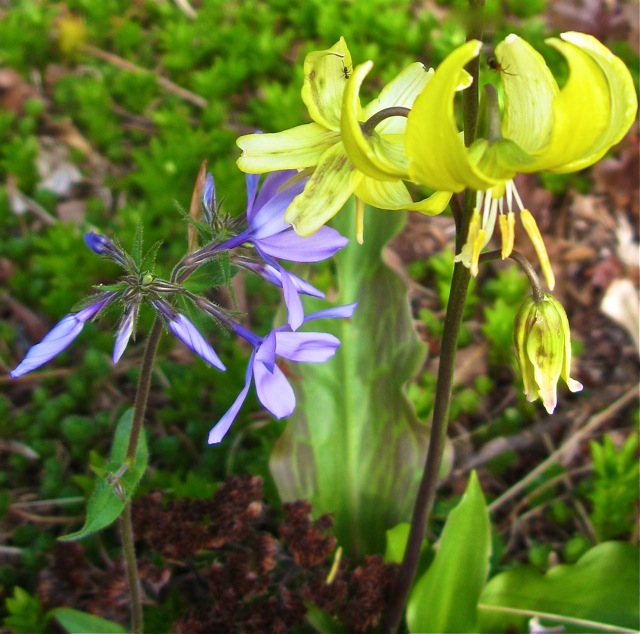Trout Lily, Fawn Lily, or Dog-tooth Violet: No Matter What You Call This Woodland Beauty, Erythronium is a Springtime Delight…
 Erythronium tuolumnense in the Secret Garden at Ferncliff © 2010 Michaela TGE
Erythronium tuolumnense in the Secret Garden at Ferncliff © 2010 Michaela TGE
Fawn lily, Trout lily, Dog-tooth Violet: Beautiful, evocative and curious, the common names for the various North American Erythronium species are as delightful as the lovely woodland flower itself. In Northeastern forests, yellow trout lilies are a common, early-spring, ephemeral wildflower. As a child, I collected these tiny, golden beauties in the forest behind my home, and presented them in little bouquets to my mother. When I was a little girl, the mottled green foliage of the trout lily made me think of a frog. Soon I confused the name, and called them ‘toad lilies’ for years – even now I catch myself making the mistake. The flowers themselves remind me of little yellow hats, especially when I catch them bobbing up and down in the morning breeze; fancy and feminine, like bonnet Audrey Hepburn might have worn.
The forest surrounding my garden is filled with trout lilies at this time of the year, but the beautiful Erythronium in my Secret Garden is a different species. This Erythronium, (pictured above and below), originates from California’s Sierra range, and is highly prized for both large bloom, glossy foliage, and a tidy, clumping habit. Many beautiful Erythronium cultivars exist -including pink and white hybrids- but I have a nostalgic preference for the pretty native species, as well as the golden California girls in my Secret Garden…
 Erythronium tuolumnense and Phlox divaricata in the Secret Garden at Ferncliff © Michaela at TGE
Erythronium tuolumnense and Phlox divaricata in the Secret Garden at Ferncliff © Michaela at TGE
Trout lilies, (and their cousins, the dog-tooth violets and fawn lilies), are native to North America and are generally hardy in USDA zones 3-9, (Erythronium tuolumnense hybrids have a narrower range of 5-8). Trout lilies can be purchased potted, and planted in spring, or the corms, (bulbs), are available to plant in early fall. All Erythroniums prefer a site with moist, humus-rich but well-drained soil. Slightly acidic soil, with a lower pH is best for trout lilies. Although this lovely wildflower enjoys the soft sunshine of early spring, she should be planted in a spot where drier conditions and shade prevail in summer. Trout lilies are usually found beneath deciduous trees and shrubs in native woodlands, and they will do well in similar garden situations. Like all spring ephemerals, the foliage of Erythroniums will die back soon after flowering, leaving empty spots in the garden during the dormant period. Because of this, from a design standpoint it makes sense to combine Erythronium with other shade-tolerant plants, which will fill the holes later in the season. Ferns, Epemidium, Tiarella, Heuchera and Hosta all make good companions for Erythronium. Trout lilies also combine well with other early-blooming flowers, including Phlox divaricata, Helleborus, Narcissus, Dicentra and many other springtime beauties…
 Erythronium tuolumnense and Lamium ‘White Nancy’ in the Secret Garden at Ferncliff © Michaela at TGE
Erythronium tuolumnense and Lamium ‘White Nancy’ in the Secret Garden at Ferncliff © Michaela at TGE
 Similar… no? It seems Audrey had a thing for hats and umbrellas, and so do I – especially in the garden. (photo credit not located)
Similar… no? It seems Audrey had a thing for hats and umbrellas, and so do I – especially in the garden. (photo credit not located)
 Audrey Hepburn by Terry O’Neill
Audrey Hepburn by Terry O’Neill
 Audrey Hepburn films are some of my favorites, (Photo Still: Paris When it Sizzles, 1963, © Bob Willoughby). She is definitely a Fawn Lily to me. What do you think?
Audrey Hepburn films are some of my favorites, (Photo Still: Paris When it Sizzles, 1963, © Bob Willoughby). She is definitely a Fawn Lily to me. What do you think?
***
Article and photographs, (with noted exceptions), copyright 2010 Michaela at The Gardener’s Eden
All content on this site, (with noted exceptions), is the property of The Gardener’s Eden and may not be used or reproduced without prior written consent. Inspired by something you see here? Great! Please give credit where credit is due. It’s a small world and link-love makes for fond friendships. Stealing makes for bad dreams…
Do you enjoy visiting The Gardener’s Eden? You can help support this site by shopping through our affiliate links. A small percentage of any sale originating from The Gardener’s Eden site will go toward web hosting and maintenance costs. Thank you for your support!
***
4 Replies to “Trout Lily, Fawn Lily, or Dog-tooth Violet: No Matter What You Call This Woodland Beauty, Erythronium is a Springtime Delight…”
Comments are closed.


Hi Michaela, speaking of native varieties… After your FB post the other day regarding the Gulf Spill and Audubon I went cruising on a few links and came up with this wonderful database http://www.wildflower.org/plants/search.php?search_field=scientific+or+common+names&newsearch=true&family=Betulaceae (of which you are likely already aware) about recommended native species in our local state(s), with photos of many…
(VERMONT: http://www.wildflower.org/collections/collection.php?collection=VT )
Please share if warranted. Thanks for your blog and being on FB.
Thanks Nancy, these are excellent resources. I’m not sure if I posted that in my blogroll or not… my right bar needs some weeding! You have reminded me to get on that, and also to list this in the notes for my upcoming seminar.
All the best to you… and thank you for your wonderful comments and contributions,
xo Michaela
Thanks for this post, Michaela. I have seen these beauties while hiking and wanted to know about them. I saw several red trillium in bloom while hiking Temple Mountain last Friday. What a treat!